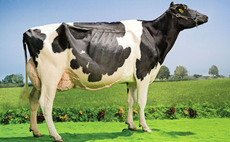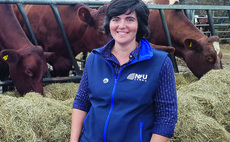Changing demographics and pressure on dairy production elsewhere in the world mean there are opportunities for growth in British dairy exports. Cedric Porter reports.
The UK is already a major dairy exporter, with the equivalent of four billion litres of milk, or a quarter of production, worth 1.4bn leaving the UK in various forms every year.
Despite this, the UK had an overall dairy trade deficit of 1.039bn in 2021, with only the value of liquid milk and milk powder shipments outweighing imports.
HMRC figures show that more than 90% of those exports are to the European Union.
The requirement for health certificates and to make custom declarations for exports to the EU as part of the Brexit agreement had an effect in 2021.
Dairy product exports were particularly hit, with cream shipments down 36%, cheese down 12%, yoghurts down 58% and whole milk powder down 26%, according to HMRC figures quoted by AHDB.
There is some evidence of a bounce-back in trade this year as British shippers become more used to the new system, which also partly applies to EU exporters to the UK. The total volume of exports was up 6.3% to 264,500 tonnes in the first three months of 2022 compared to the same period last year, with an 11% increase in cheese exports.
Non-EU market growth
Part of the Governments post-Brexit aim is to sell more to non-EU markets and it is clear to see that is where long-term opportunities lie.
UN figures estimate the world population will be 7.5% larger by 2030 and 22.4% bigger by 2050 at 9.735 billion people. However, the number of Europeans is set to shrink by 5% by 2050.
The average person in the world consumes the equivalent of 70.8kg of milk a year, calculates the UN Food and Agriculture Organisation (based on 2019 estimates). So if consumption holds the same, the volume of milk needed will increase from 563 million tonnes this year to 689mt by 2050.
However, European demand will drop from 133mt to 127mt if its consumption rate stays at its current 178.4kg a year. Dietary and climatic pressure in Europe might mean the consumption rate may fall in the coming decades, which would also impact on demand.
The worlds largest dairy market in the world is Asia, accounting for almost half of global milk consumption at 226mt of milk. That could jump to 254mt if the current consumption rate of 48kg/head/year is maintained.
Fastest growth is expected in Africa, where the population between 2022 and 2050 is expected to soar by 77%. That would require 61mt of milk if current consumption of 24.6kg/head a year is maintained.
Peak milk in some countries
Milk output has jumped dramatically in fast-growing populations over the last 20 years more than doubling in Asia and up by 80% in Africa.
But gains have been more modest in major export countries. European output has increased by less than 10% since 2000, with production up less than one-third in North America and Australasia.
Some of those exporting giants may have reached peak milk. New Zealand exports more dairy products by value than any other country, but it now has a plan to reduce its national herd by up to 15% to meet its 2050 climate change targets.
The number of US dairy cows has hovered around 9.4 million head for the last 10 years, although there has been a 1% a year increase in cow yields over the last decade. The number of EU dairy cows has fallen by more than 5% over the last decade to 20m.
The potential for increased output in the UK to meet new export market demand is significant. In 2021, there were 1.85m dairy cows on UK farms, that was 43% less than 40 years before.
If those numbers were reached again and they achieved the average national yield of 8,100 litres of milk per cow per year, UK production could increase to 21 billion litres a year.
Export strategy
The NFU highlighted dairy as a major opportunity in its recent export strategy.
It said: The ever-increasing global population and increasing wealth in developing nations is driving the demand for dairy up significantly every year.
Developing countries also offer opportunities with many unable to keep up with demand through their own domestic production, so will fall in to a deficit of dairy.
The UKs dairy industry has identified emerging markets in Central and South America, Africa and Asia, including China and India. These countries are all predicted to be running large deficits of dairy products by 2027 and British dairy products are well placed to service this demand.
Currently the UKs largest non-EU dairy markets are China (83 million), USA (63m), United Arab Emirates (22m), Algeria (22m) and Australia (17m).
At the launch of its export strategy, NFU president Minette Batters said: We should not be afraid to take a leaf out of our competitors playbooks either.
The likes of Australia, New Zealand and the USA are competitive exporters because they put the experts and resources into their target markets. That is something our Government should be looking to emulate and work with farmers to achieve.
Working with trading partners where production is under pressure, such as New Zealand, could be one way forward for the UK dairy industry.
Anchor butter is already made under licence in the UK by Arla and New Zealands largest milk processor Fonterra has recently announced joint ventures with US dairies to expand its global reach.
NFUs 10-point plan
The NFU came up with a 10-point plan to improve the UKs food export prospects:
Understand strengths
Identify the best overseas markets for success
Unlock those markets
Invest in technical expertise
Support public/private research and development
Ensure domestic infrastructure supports international trade
Domestic support for exporters
Create a one-stop-shop for exporting UK food businesses
Boost marketing and promotion
Strategic co-ordination and ownership




















